CONSTRUCTIONS for Class 9 MATHS
INTRODUCTION
Hello bachcho, aapne abhtak bahot sare diagrams, figures banaye hoge kisi theorem ko proof karne ya exercise ko solve karne ke liye par wo ekdum accurate nahi the wo to bas aapko situation ko feel karane ke liye banate the aur aapko ek proper reasoning dene ke liye. But kabhi kabhi hume ekdum accurate figure ya diagram ki zarurat hoti hai, for example :- to draw a map of a building to be constructed, to design
tools, and various parts of a machine, to draw road maps etc. To inn sab figures ko draw karne ke liye aapko kuch basic geometrical instruments ki zarurat padegi. Toh aapke geometry box mai kuch important aur basic tools hone chahiye, for example :-
(i) Ek graduated scale yani ki jiske ek side par clearly centimetres and millimetres mark ho aur dusri side par clearly inches and their parts mark ho.

(ii) A pair of set - squares, one with angles 90∘, 60∘ and 30∘ and other with angles
90∘, 45∘ and 45∘.

(iii) A pair of dividers (or a divider) with adjustments.
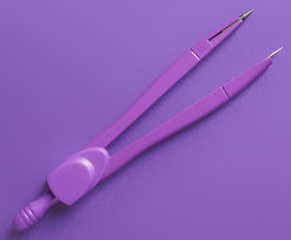
(iv) A pair of compasses (or a compass) with provision of fitting a pencil at one end.

(v) A protractor

Toh bachcho inn instruments ke saath construction karna shuru karte hai.
Explanation
Toh bachcho jo instruments humne abhi upar padhe wo normally geometrical figures draw karne ke liye use karte hai jaise ki circle, parallelogram, polygon, etc. But a geometrical construction is the process of drawing a geometrical figure using only two instruments – an ungraduated ruler, also called a straight edge and a compass. Construction mai jaha par measurement ki requirement hoti hai waha par aap graduated scale and protractor use kar sakte hai. Iss chapter mai aapko kuch basic constructions dekhne ko milenge.
Construction
Construction in geometry means to draw shapes, angles or lines accurately. These constructions use only compass, straightedge (i.e. ruler) and a pencil.
Basic Constructions
Aapne Class VI mai circle ko construct karna sikha tha and the perpendicular bisector of a line segment, angles of 30∘,45∘,60∘,90∘ and 120∘ and the bisector of a given angle, aap inn constructions ko bina kisi justification ke banate the. Abh aap iss section mai construction karoge but with proper reason and justification that why these constructions are valid.
Example 1
Construct an angle of 60∘ using ruler and compasses only Justify your construction.
STEPS OF CONSTRUCTION :-
(i) Draw a ray OA.
(ii) With O as centre and a convenient radius, draw an arc, cutting OA at P.
(iii) With P as centre and the same radius as above, draw an arc, cutting the previous arc at Q.
(iv) Join OQ and produce it to a point B.
Then, ∠AOB is the required angle of measure 60∘.

Verification :
If you measure ∠AOB by using a protractor, you will find that ∠AOB=60∘.
Justification :
Join PQ, as shown in the figure.
Then, OQ=OP=PQ (by construction)
∴ΔOPQ is an equilateral triangle.
Hence, ∠POQ=60∘ and therefore, ∠AOB=60∘.
Example 2
Construct a ΔABC in which BC=6 cm, ∠B=60∘ and (AB+AC)=9 cm. Measure AB and AC. Justify your answer.
STEPS OF CONSTRUCTION
(i) Draw BC=6 cm.
(ii) Construct ∠CBX=60∘.
(iii) Along BX, set off BP=9 cm.
(iv) Join CP.
(v) Draw the perpendicular bisector of CP to intersect BP at A.
(vi) Join AC.
Then, ΔABC is the required triangle.
Verification :
On measuring, we find that
AB+AC=(4+5) cm =9 cm.
Justification :
Clearly, A lies on the perpendicular bisector of CP.
∴AP=AC.
Now, BP=9 cm [see Step (iii)]
⇒AB+AP=9 cm
⇒AB+AC=9cm [∵AP=AC].
Hence, ΔABC is the required triangle.

Construction 11.1
To construct the bisector of a given angle.
Given an angle ABC, we want to construct its bisector.
Steps of Construction :
1. Taking B as centre and any radius, draw an arc to intersect the rays BA and BC, say at E and D respectively. [fig. (i)]
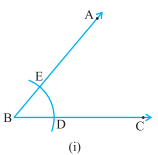
2. Next, taking D and E as centres and with the radius more than 12 DE, draw arcs to intersect each other, say at F.
3. Draw the ray BF . This ray BF is the required bisector of the angle ABC. [fig. (ii)]

Justification
From Construction,
Join DF and EF.
In triangles BEF and BDF,
BE=BD (Radii of the same arc)
EF=DF (Arcs of equal radii)
BF=BF (Common)
∴ ΔBEF≅ΔBDF
( SSS rule)
This gives ∠EBF=∠DBF(CPCT)
Construction 11.2
To construct the perpendicular bisector of a given line segment.
Given a line segment AB, we want to construct its perpendicular bisector.
Steps of Construction :
1 . Taking A and B as centres and radius more than 12 AB, draw arcs on both sides of the line segment
AB (to intersect each other).
2. Let these arcs intersect each other at P and Q.
Join PQ.

3. Let PQ intersect AB at the point M. Then line PMQ is the required perpendicular bisector of AB.
Justification
From Construction,
Join A and B to both P and Q to form AP, AQ, BP and BQ.
In triangles PAQ and PBQ,
AP=BP (Arcs of equal radii)
AQ=BQ (Arcs of equal radii)
PQ=PQ (Common)
∴ ΔPAQ≅ΔPBQ ( SSS rule)
So, ∠APM=∠BPM(CPCT)
Now in triangles PMA and PMB,
AP=BP (As before)
PM=PM (Common)
∠APM=∠BPM (Proved above)
∴ ΔPMA≅ΔPMB ( SAS rule)
So, AM=BM and ∠PMA=∠PMB (CPCT)
As ∠PMA+∠PMB=180∘ (Linear pair axiom),
we get,
∠PMA=∠PMB=90∘.
Therefore, PM, that is, PMQ is the perpendicular bisector of AB.
Construction 11.3
To construct an angle of 60∘ at the initial point of a given ray.
Let us take a ray AB with initial point A. We want to construct a ray AC such that ∠CAB=60∘. One way of doing so is given below.

Steps of Construction :
1. Taking A as centre and some radius, draw an arc of a circle, which intersects AB, say at a point D.
2. Taking D as centre and with the same radius as before, draw an arc intersecting the previously
drawn arc, say at a point E.
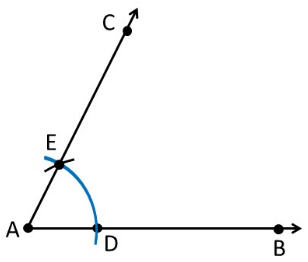
Draw the ray AC passing through E.
Then ∠CAB is the required angle of 60∘.
Justification
From Construction,
Join DE.
Then, AE=AD=DE (By construction)
Therefore, ΔEAD is an equilateral triangle and the ∠EAD, which is the same as ∠CAB is equal to 60∘.
Some Constructions of Triangles
Abhi tak aapne kuch basic construction dekhe hai. Next, abh hum triangles ki construction dekhenge by using above mentioned instruments. Recall from the Chapter 7 that SAS,SSS,ASA and RHS rules give the congruency of two triangles. Therefore, a triangle is unique if :
(i) Agar triangle ki koi two side and included angle given ho
(ii) Triangle ki tino side given ho,
(iii) Agar triangle ke two angle and included side given ho,
(iv) In a right triangle, hypotenuse and one side is given.
Aapne already Class VII mai inn triangles ko construct karna sikha tha.
Now, let us consider some more constructions of triangles. Aapne yaha par ek cheej notice ki hogi triangle ko construct karne ke liye hume atleast three parts pata hone chahiye. But not all combinations of three parts are sufficient for the purpose. For example, if two sides and an angle (not the included angle) are given, then it is not always possible to construct such a triangle uniquely.
Example 3
Construct a ΔABC whose perimeter is 12cm and the base angles are 60∘ and 70∘. Justify the construction.
STEPS OF CONSTRUCTION
(i) Draw a line segment PQ=12 cm.
(ii) Make ∠QPR=60∘ and ∠PQS=70∘.
(iii) Draw the bisectors of ∠QPR and ∠PQS to meet at A.
(iv) Draw the perpendicular bisectors of PA and QA to meet PQ at B and C respectively.
(v) Join AB and AC.
Then, ΔABC is the required triangle.

Justification :
Since B lies on the perpendicular bisector of AP, we have BA=BP. Since C lies on the perpendicular bisector of AQ, we have CA=CQ. Thus, AB=PB and AC=CQ.
∴AB+BC+AC=PB+BC+CQ=PQ=12 cm.
Now, BA=BP⇒∠BPA=∠BAP
⇒∠ABC=∠BPA+∠BAP=2∠BPA
=2×12×60∘=60∘.And, CA=CQ⇒∠CQA=∠CAQ
⇒∠ACB=∠CQA+∠CAQ=2∠CQA
=2×12×70∘=70∘.
Verification :
On measurement, we find that
AB+BC+CA=(4.4+3.5+4.1)cm=12 cm.
∠B=60∘ and ∠C=70∘.
Example 4
Construct a ΔABC in which base BC=5.2cm, ∠ABC=50∘ and AB−AC=2cm.
Steps of construction :
1. Draw BC=5.3cm.
2. Construct ∠PBC=50∘ and cut BP=2cm.
3. Join PC.
4. Draw the perpendicular bisector of PC which intersect BP produced at A.
5. Join AC.
∴ΔABC is the required triangle.
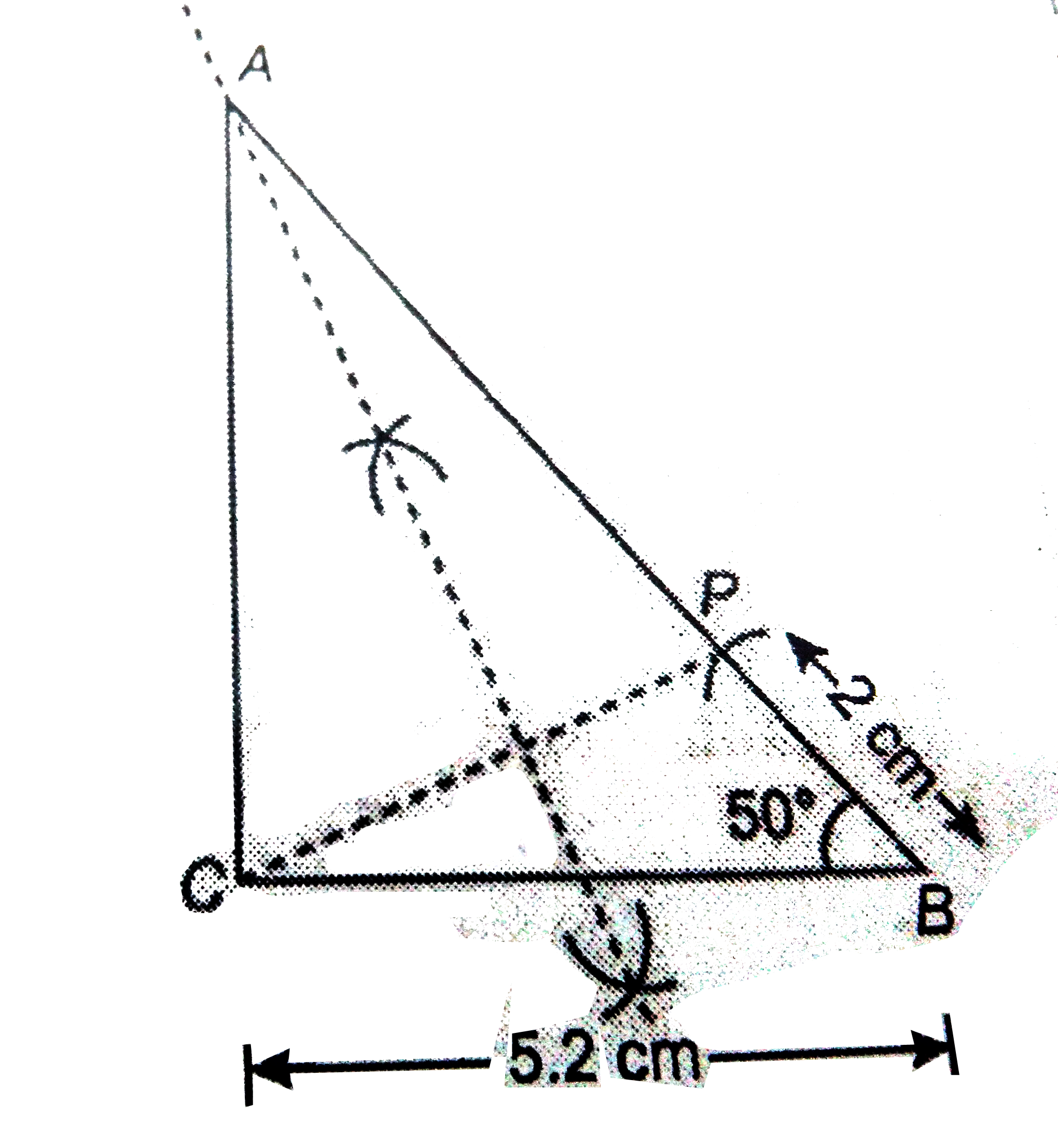
Construction 11.4
To construct a triangle, given its base, a base angle and sum of other two sides.
Given the base BC, a base angle, say ∠B and the sum AB+AC of the other two sides of a triangle ABC, we have to construct it.
Steps of Construction :
1. Draw the base BC and at the point B make an angle, say XBC equal to the given angle.
2. Cut a line segment BD equal to AB+AC from the ray BX.
3. Join DC and make an angle DCY equal to ∠BDC.
4. Let CY intersect BX at A.
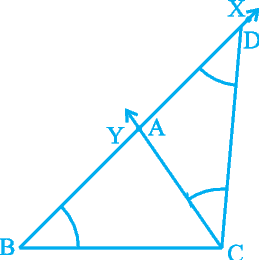
Then, ABC is the required triangle.
Justification
From Construction,
Base BC and ∠B are drawn as given. Next in triangle
ACD,
∠ACD=∠ADC (By construction)
Therefore, AC=AD and then
AB=BD–AD
AB=BD–AC
AB+AC=BD
Construction 11.5
To construct a triangle given its base, a base angle and the difference of the other two sides.
Let △ABC with ∠B and base BC be given.
Now, we are also difference of other two sides.
So, There can be two cases :-
1.AB>AC and difference AB−AC is given.
2.AC>AB and difference AC - AB is given.
Let's do both these cases separately.
Case 1: AB > AC
Given the base BC, a base angle ∠B and the difference AB−AC we need to construct △ABC.
Steps of Construction :
1. Draw base BC.
2. Now, let's draw ∠B.
Construct angle B from point B.
Let the ray be BX.
3. Open the compass to length AB−AC. [ Since AB>AC, (AB - AC) is positive.
So, BD will be above line BC ]
From point B as center, cut an arc on ray BX.
Let the arc intersect BX at D.
4. Join CD.

5. Now, we will draw perpendicular bisector of CD.
6. Mark point A where perpendicular bisector intersects BD.
7. Join AC.
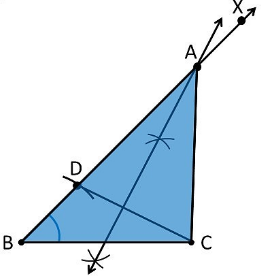
∴△ABC s the required triangle.
Case 2 :- AC>AB
Given the base BC, a base angle ∠B and the difference AC−AB, we need to construct △ABC.
Steps of Construction :
1. Draw base BC.
2. Now let's draw ∠B
Construct angle B from point B.
Let the ray be BX.
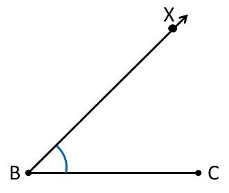
3. Open the compass to length AC−AB. [ Since, AC>AB (AB−AC) is negative.
So, BD will be below line BC ]
From point B as center, cut an arc on ray BX (opposite side of BC ).
Let the arc intersect BX at D.
Join CD.
5. Now, we will draw perpendicular bisector of CD.
6. Mark point A where perpendicular bisector BD.
7. Join AC.
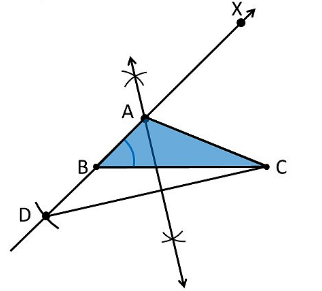
∴△ABC is required triangle.
Justification
Justification Case 1 :-
We need to prove that AB−AC=BD.
Let perpendicular bisector intersect CD at point R.
Thus,
AR is the perpendicular bisector of CD
∴CR=DR......(1)
∠ARC=∠ARD=90∘.......(2) >
Now,
In △ADR and △ACR
AR=AR (common)
∠ARD=∠ARC (From (2))
DR=CR (From (1))
∴△ADR≅△ACR ( SAS Congruency )
⇒AC=AD (CPCT)........(3)
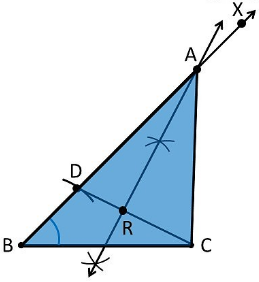
Now,
BD=AB−AD
BD=AB−AC (From (3))
Thus, our construction is justified.
Justification Case 2 :-
We need to prove that AC−AB=BD.
Let perpendicular bisector intersect CD at point R.
Thus,
AR is the perpendicular bisector of CD
∴CR=DR......(1)
∠ARC=∠ARD=90∘.......(2)
Now,
In △ADR and △ACR
AR=AR (common)
∠ARD=∠ARC (From (2))
DR=CR (From (1))
∴△ADR≅△ACR ( SAS Congruency )
⇒AC=AD (CPCT)........(3)
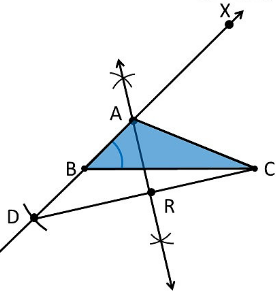
Now,
BD=AD−AB
BD=AC−AB(From(3))
Thus, our construction is justified.
Construction 11.6
To construct a triangle, given its perimeter and its two base angles.
Given the base angles, say ∠B and ∠C and BC+CA+AB, we have to construct the triangle ABC.
Steps of Construction :
1. Draw a line segment, say XY equal to BC+CA+AB.
2. Make angles LXY equal to ∠B and MYX equal to ∠C.
3. Bisect ∠LXY and ∠MYX. Let these bisectors intersect at a point A.
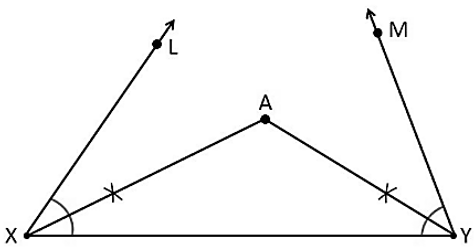
4. Draw perpendicular bisectors PQ of AX and RS of AY.
5. Let PQ intersect XY at B and RS intersect XY at C.
Join AB and AC.

Then ABC is the required triangle.
Justification
For the justification of this construction, you observe that, B lies on the perpendicular bisector PQ of AX.
Therefore, XB=AB and similarly, CY=AC.
This gives BC+CA+AB=BC+XB+CY=XY
Again,
∠BAX=∠AXB (As in ΔAXB,AB=XB) and
∠ABC=∠BAX+∠AXB=2∠AXB=∠LXY
Similarly,
∠ACB=∠MYX as required.
Tips

Summary
In this chapter, you have done the following constructions using a ruler and a compass:
- To bisect a given angle.
- To draw the perpendicular bisector of a given line segment.
- To construct an angle of 60∘ etc.
- To construct a triangle given its base, a base angle and the sum of the other two sides.
- To construct a triangle given its base, a base angle and the difference of the other two sides.
- To construct a triangle given its perimeter and its two base angles.